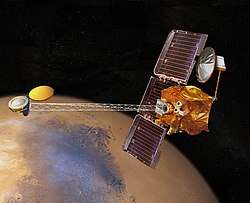Mars-Grunt
Mars-Grunt, also known as Expedition-M (Russian: Марс-Грунт),[5] is a robotic spacecraft sample return mission proposed to be sent to Mars in mid-2020s.[4][6][7][8][9] It was proposed to the Russian Federal Space Agency (Roscosmos) by the Russian Space Research Institute.
| Names | Expedition-M |
|---|---|
| Mission type | Single launch: orbiter, lander, ascent vehicle, sample-return |
| Operator | Russian Federal Space Agency |
| Spacecraft properties | |
| Bus | Pereletny Modul or Flagman [1] |
| Manufacturer | NPO Lavochkin Russian Space Research Institute |
| Launch mass | 5,200 kg[2] |
| Landing mass | 1,700 kg,[2] includes Service Module (500 kg), Mars Ascent Vehicle (700 kg), Return Capsule (40 kg)[2] |
| Dry mass | Orbiter: 50 kg (110 lb) |
| Power | solar array |
| Start of mission | |
| Launch date | 2024 (proposed)[2][3] |
| Rocket | Angara-5/DM-03 [2] |
| Mars orbiter | |
| Orbital parameters | |
| Peri altitude | 500 km (310 mi) |
| Apo altitude | 500 km (310 mi) |
| Mars lander | |
| Sample mass | ≈0.2 kg (0.44 lb)[4] |
Lander
If funded by the Russian space agency Roscosmos, it would be developed by the Russian Space Research Institute and NPO Lavochkin, based on Fobos-Grunt technology.[10] Designs show a dome-shaped lander would separate from the orbiter and would enter the Martian atmosphere protected within an inflatable rubber braking cone and fire retrorockets for a soft landing.[11] Once a robotic arm selects and retrieves the samples (mass about 0.2 kilograms (0.44 lb)),[4] a small rocket in the top of the lander would blast the ascent vehicle for rendezvous and docking with the orbiter for the soil sample transfer into the return vehicle.
Cruise stage
The cruise stage PM (from Pereletny Modul Russian: Перелётный Модуль) is sometimes referred to as Flagman. It was developed for the Fobos-Grunt mission, but its basic architecture is promised to be the base for a whole generation of future planetary missions, including Luna-Glob, Luna-Resurs and Luna-Grunt to the Moon; Venera-D to Venus; Mars-NET and Mars-Grunt to Mars and, possibly, Sokol-Laplas to Jupiter. The platform's developer - NPO Lavochkin - stressed that in different configuration, the same bus could be adapted as an orbiter or as a lander.[1]
Status
If the technology being developed for Luna Glob to the Moon, and Fobos-Grunt 2 to Mars' moon Phobos, is proved successful, it will then be used on Mars-Grunt.[12]
See also
References
- Phobos-Grunt design
- Pietrobon, Steven (11 August 2018). "Russian Launch Manifest". Retrieved 11 August 2018.
- Russia takes a two-pronged approach to space exploration April 17, 2012.
- Roscosmos - Space missions Published by The Space Review (p. 8-10, 19) on 2010
- "Russian space program: a decade review (2010-2019)". Russianspaceweb. Retrieved 7 August 2015.
- "Russia takes a two-pronged approach to space exploration". Retrieved 27 October 2015.
- "The Space Review: Red Planet blues". Retrieved 27 October 2015.
- Russia To Study Martian Moons Once Again. Mars Daily July 15, 2008.
- Major provisions of the Russian Federal Space Program for 2006-2015. "1 spacecraft for Mars research and delivery of Martian soil to the Earth."
- Phobos-Grunt prepares for launch. ATO - 16 August 2011.
- Russian Space Probes: Scientific Discoveries and Future Missions. By Brian Harvey, Olga Zakutnyaya. (p 475)
- Mars Sample Return - Russia. Anatoly Zak and Alain Chabot. Russian Space Web. May 4, 2017.

.jpg)
.jpg)
